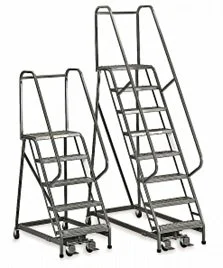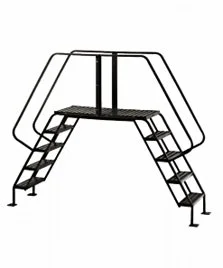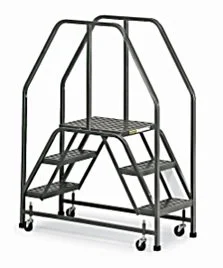-
A rolling ladder is a mobile access platform designed to help workers safely reach elevated storage areas, shelving, or machinery. It’s typically built from steel, aluminum, or fiberglass, and mounted on casters or spring-loaded wheels for smooth movement. When stepped on, the ladder locks into place to prevent movement, ensuring stability during use. Rolling ladders are commonly found in warehouses, libraries, and retail stockrooms where frequent access to high storage is needed.
-
Steel Rolling designs are built for rugged, everyday use in busy aisles, a great fit when you need a warehouse ladder that resists dings and flex. A steel ladder typically offers a higher load rating and a more planted feel on long runs, with full-size handrails that support steady contact on every step and at the platform. Aluminum is chosen when lower weight and frequent moves are priorities, as they can add ease of use.
-
Match the tread to your surface and traffic. A perforated tread gives a strong grip and sheds debris, which is good for dusty or oily areas. Expanded-metal styles bite into boot soles for maximum traction, while solid ribbed treads feel smoother underfoot for clean, finished floors. Consider your typical loads, aisle conditions, and required height when selecting the tread and step count.
-
A deep top step (often called a deep top or oversized top step) provides extra standing room at working height so you can stage parts, face forward, or operate tools comfortably. Choose a deep top step when tasks require longer dwell time at elevation, good for stock picking, labeling, scanning, or assembly. It’s also useful when you need room to pivot safely with two feet planted before descending the next step.
-
Warehouses and distribution centers (stock picking, inventory organization)
Retail stores (accessing upper shelves or signage)
Manufacturing facilities (maintenance or assembly line access)
Libraries and offices (book or file retrieval)
Aircraft and automotive maintenance (accessing tall vehicles or equipment)
They’re preferred because they combine height access with mobility, reducing the need for unsafe alternatives like climbing on shelves or using forklifts for access.
-
A folding ladder is a portable ladder with hinged sections that collapse for easy storage and transport. It’s designed to provide access to moderate heights safely and can be configured in various positions (A-frame, extension, or platform depending on model). You’ll find folding ladders everywhere — from home garages and construction sites to maintenance and light industrial workspaces — because they’re compact, versatile, and don’t require wall support.
-
Absolutely. Before climbing, lock all hinges and spreaders completely open so the ladder can’t collapse. A partially unfolded or unlocked ladder is a leading cause of ladder-related injuries. You should hear or feel a click when hinges are locked properly.
-
Not required by OSHA for short folding ladders, but highly recommended. Many folding ladders include extended handholds or safety bars to help maintain balance. For commercial or frequent-use applications, models with integrated safety handles or platform rails are worth it.
-
Aluminum – Lightweight, rust-resistant, and affordable. Ideal for general use.
Fiberglass – Non-conductive, stronger, and safer for electrical work.
Steel – Heavy-duty, but heavier and prone to corrosion without coating.
Plastic/Composite – Lightweight and used for household or short-reach applications.
Tip: If you’re working around electricity, go fiberglass — never metal.
-
Your working height should be about 4 feet higher than your ladder height.
Example:For an 8 ft ceiling, a 4–5 ft ladder is ideal.
For 12 ft ceilings, go with a 7–8 ft ladder.
Avoid standing on the top step unless it’s rated as a platform.
Crossover Ladders
-
A crossover ladder (or crossover platform) is a fixed or mobile structure that allows workers to safely pass over obstacles such as conveyor belts, assembly lines, pipes, or machinery.
It typically consists of:Two stairways (ascent and descent sides)
A central platform or bridge
Handrails and guardrails for fall protection
Crossover ladders are designed for continuous, safe access between areas that would otherwise require workers to walk around or step over obstructions — reducing travel time and trip hazards.
-
They’re used across a wide range of facilities, including:
Manufacturing and production plants (over machinery or lines)
Warehouses and logistics centers (crossing conveyors or storage lanes)
Maintenance areas (access over piping, ducts, or equipment)
Chemical and food processing (separating walkways from sensitive zones)
Energy and utilities (crossing cables, pumps, or pipelines)
Essentially, anywhere workers need safe passage over obstacles that can’t be moved.
-
They can be either, depending on the model:
Permanent (fixed): Bolted to the floor for long-term installation over machinery or walkways.
Mobile (modular): Mounted on locking casters and moved as needed, often made of lightweight aluminum.
Permanent models are more common in manufacturing environments, while modular or portable crossovers are used in maintenance and flexible layouts.
-
Because walking around machinery or conveyors often means:
Longer travel routes (lost productivity)
Crossing into unsafe zones (risk of injury)
Stepping over hazards (risk of tripping or falling)
Crossover ladders provide a designated safe path that:
Reduces travel time
Improves safety compliance
Keeps foot traffic away from moving parts or floor-level hazards
They’re a safety and efficiency upgrade rolled into one.
-
Fixed models: Anchored to the floor with bolts or base plates.
Mobile models: Use locking casters, floor brakes, or spring-loaded wheels that automatically lock under weight.
Before each use, verify that all locking mechanisms engage properly.
-
An aluminum ladder is a lightweight, corrosion-resistant ladder made primarily from extruded aluminum alloys. They’re common in construction, warehousing, maintenance, and residential use because they’re strong yet easy to carry and store.
-
A stainless steel ladder is a heavy-duty, corrosion-resistant ladder built for industrial, marine, and food-service environments where hygiene or durability is critical. They’re designed to withstand harsh chemicals, moisture, and temperature extremes without rusting or degrading.
-
They’re widely used for:
Home and DIY tasks – painting, repairs, roof access
Construction and maintenance – light-to-medium duty access work
Warehouses and factories – inventory, light installation work
Transportation and utilities – inspections, repairs, servicing
Basically, anywhere you want a sturdy ladder that won’t rust and doesn’t weigh a ton.
-
Food and beverage plants (cleanroom or washdown areas)
Pharmaceutical facilities (sterile environments)
Chemical plants (corrosive exposure)
Marine and offshore industries (saltwater resistance)
Industrial maintenance (high-load or harsh environment access)
These are not household ladders — they’re built for precision and endurance.
-
Aluminum Ladders
Lightweight – Easy to move and transport.
Corrosion-resistant – Won’t rust, even in humid conditions.
Durable – High strength-to-weight ratio.
Low maintenance – No paint or coating required.
Cost-effective – Typically cheaper than fiberglass or stainless.
They’re ideal for users who value mobility and convenience over maximum load capacity.
Stainless Steel Ladders
Corrosion-resistant – Excellent for wet, chemical, or marine settings.
High strength – Superior load capacity and impact resistance.
Long service life – Decades of use with minimal degradation.
Easy to sanitize – Smooth finish allows for sterile cleaning.
Fire and heat resistant – Won’t deform or melt under high temps.
They’re the premium choice for reliability and hygiene-critical operations.
-
A mobile platform is a movable elevated work surface designed to give workers safe access to elevated areas. It typically consists of a platform with guardrails, mounted on locking casters or wheels for easy repositioning. Unlike simple ladders, mobile platforms are designed for working at height for extended periods, not just climbing up and down. They’re sometimes called mobile work platforms, rolling platforms, or portable access platforms.
-
Mobile platforms are used across nearly every industry:
Warehousing and distribution centers (picking, stocking, inventory)
Maintenance and facilities (HVAC, lighting, painting, cleaning)
Manufacturing and assembly lines (equipment access, quality checks)
Transportation sectors (bus, train, and aircraft servicing)
Food and chemical plants (inspection or sanitation access)
Basically, anywhere workers need safe, stable elevated access that can be moved without heavy equipment.
-
They must meet OSHA 29 CFR 1910.29 (fall protection systems) and ANSI MH30.3 / ANSI A14.7 (mobile ladder stands and platforms).
Key OSHA requirements:Guardrails on all open sides (42" height minimum)
Midrails and toe boards
Slip-resistant surfaces
Locking casters when in use
Rated for intended loads
Failure to comply can result in serious citations — especially in facilities or production settings.
-
Yes — that’s common.
Manufacturers can tailor:Platform height and length
Access type (stairs, ladder, or crossover)
Handrail configuration
Caster size and brake style
Material type (aluminum, galvanized steel, stainless)
Some facilities order platforms designed to fit specific machinery, tanks, or vehicles.
-
Standard models range from 18 inches to 15 feet in platform height.
Custom designs can exceed that, but OSHA requires additional fall protection above certain heights.
For routine access tasks, 3–6 ft platforms are most common.





